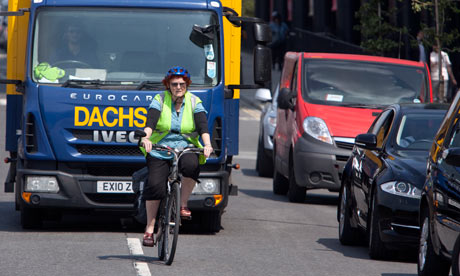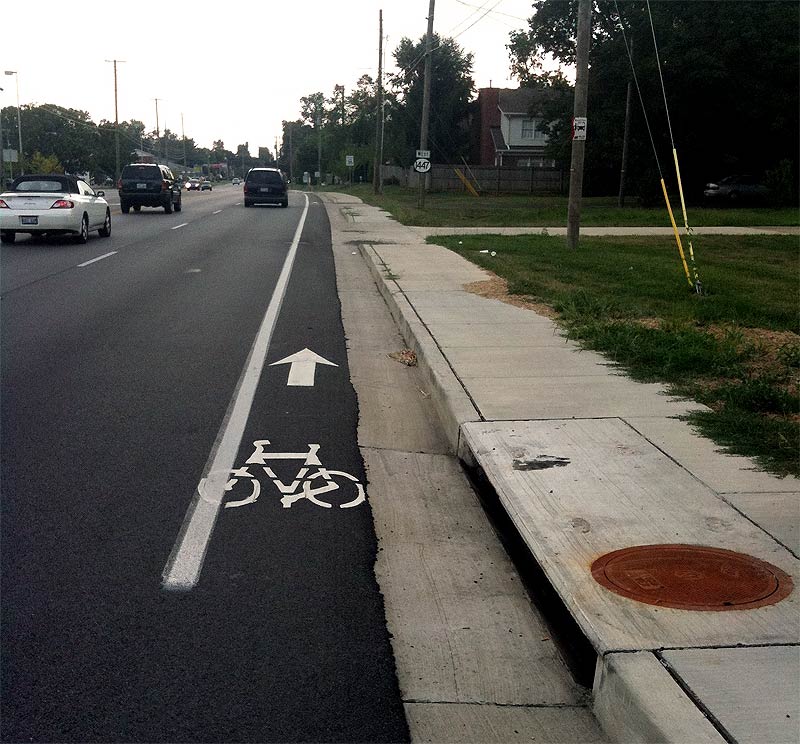I've seen it argued many times on many blogs that people feel excluded from cycling. That if only we could have a vast network of segregated facilities, people would turn up in droves to cycle on them.
The thing is, as far as I can see, it just ain't so. The real problem is that the vast majority of people simply do not want to cycle. Sure, people often say "If it was safe, I'd cycle", but the fact is, it is safe (at least as safe as driving and possibly up to twice as safe, according to stats I've seen) and people still don't cycle.
The fact is, motorized transport is too convenient and people are too lazy.
But even if they weren't too lazy, the fundamental problem with populist infrastructure advocacy (segregation) is that its devotees promote infrastructure by supporting the very fear of traffic that the non-cyclists use as an excuse. It would be all well and good to say "We need infrastructure because roads are scary" IF a complete network of good quality fully segregated cycling infrastructure already existed, but the harsh truth is that it DOESN'T exist, nor will it ever exist. Whether the segregationists like it or not, most cycling has to be done on the road with traffic, and while that's the case, supporting fear can only result in more people being unwilling to cycle.
So I think that if segregationists truly want to see a significant rise in cycling mode share anytime soon, they need to get beyond using fear as a tool to get their way, so that the lazy masses have no more excuses.
But even if we got beyond the fearmongering, there's another big problem, and that is that populist cycling advocacy has no problem with poor facilities. The general attitude is "Yeah, it's not great, but it's better than nothing". But no, it isn't. Facilities like this dangerously narrow two-way bike lane:
...or this incorrectly striped bike lane:
...or this bike track which Streetsblog says "attracts 2.5 times as many cyclists as comparable streets with no bike lane" but which encourages wrong-way cycling and keeps cyclists dangerously removed from motorists' sight until they reach an intersection:
...or even this door zone bike lane, which Streetsblog.org lauded as an example of "Baltimore Getting Serious About Bikes":
...these are not better than nothing. The fact is, they end up injuring and killing cyclists with greater frequency than roads that are not 'bicycle friendly', as a recent study of bicycle facilities in Washington DC found, but glossed over.
The segregationists need to have at least some standards so they can draw some line between good and bad facilities. But right now, I don't see any criticism of anything - the general attitude is that if it's laid down for the exclusive use of cyclists, it's good, no matter how dangerous or useless it is, and God help anyone who criticizes it. This is play advocacy, because anything goes and there are no controls to make sure that what's being supported has real merit. The play-advocate gets to go to meetings, petition government, yell at and generally express loathing for opponents who do have standards, and declare victory for anything that gets done. The difference between play advocacy and real advocacy is standards, and in practice, populist bicycle advocacy has none.
We need mature advocacy, not play advocacy, so that people can't use the tired old excuses to avoid cycling. If we can get real advocacy, we can remove the barriers between people and bikes. Maybe then, people will start cycling in droves. Heck, maybe then, the facilities that the segregationists support will no longer be a joke, and even someone like me will be able to support them.






I assume this is in response to the Streetsblog post that blasted John Allen?
ReplyDeleteHi Khal,
DeleteActually it's in response to an old blog post I saw on 'Roads Were Not Built For Cars'. For me, Streetsblog is just the 'go-to' guy for finding rabid and uncritical support for bad bike facilities. I guess perhaps the recent Streetsblog shenanigans might have had some level of subconscious influence - nothing conscious though.
I found the link:
Deletehttp://www.roadswerenotbuiltforcars.com/stevenage/
"Roads were not built for cars" and I suppose "Airports were not built for jets". I don't see Luddite stances as being very productive. For a variety of reasons good and bad, and with both some positive and some very negative consequences, the public embraced the car.
ReplyDeleteWe need to reign in car use for a variety of reasons including urban congestion, pollution, carbon footprints, and public safety, but in a manner that is likely to gain some support from the masses who use them. Car-hatred and uncritical love of bicycle facilities seems to go hand in glove.
I don't think the 'Roads Were Not Built For Cars' guy (Carlton Reid) is a luddite. He's just working to change the misconception that roads were originally built with the motorist in mind, and trying to educate people about the 'Good Roads Movement' that built the American and British road networks in the late 1800s. Far from wanting to smash car culture, he seems to be bending over backwards to work against divisiveness by illustrating how motorists and cyclists have more in common than either group might think.
DeleteHe also tries to walk the fine line between vehicular cycling and infrastructure advocacy.
He's far too conciliatory for my taste, both in terms of his unwillingness to criticize car culture and in his acceptance of the bike facility crowd's mindset - but I guess that's what you need to do when you're the editor of Bikebiz.com.
Yeah, you are right. I kinda "shot from the lip" on that one.
DeleteThe world would be no fun if we couldn't occasionally shoot from the lip. As I get older, I'm looking forward to doing it all the time and forcing the younger generation to just humor me.
DeleteThe Baltimore bike lane, not the Door Zone only: That's the signpost up ahead—your next stop, the Taillight Zone.
DeleteWhat I got out of the DC study was that more people cycle in the summer
ReplyDeletethen the winter and the crash rate is 3.5 times then before the cycle tracks
were installed.
5 crashes in 13 months with facilities versus 4 in 4 years before facilities is a pretty dramatic and significant rise. The report laughingly suggests more study is needed before a conclusion may be drawn.
ReplyDelete